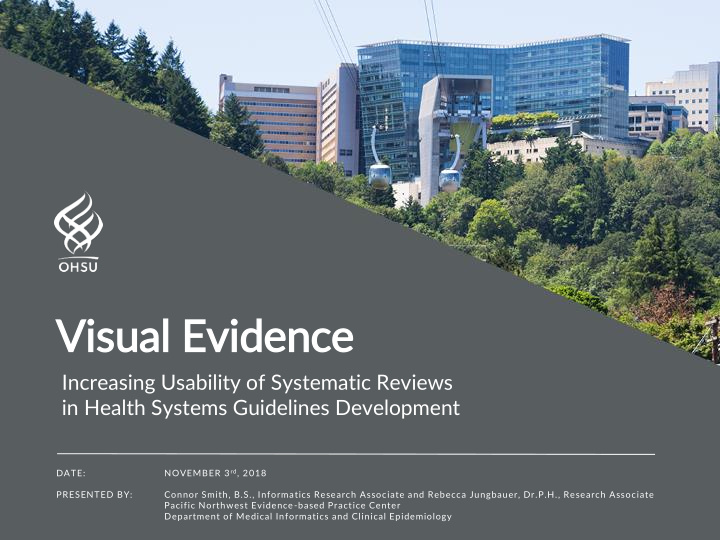



Vis isual Evidence Increasing Usability of Systematic Reviews in Health Systems Guidelines Development DATE: NOVEMBER 3 rd , 2018 PRESENTED BY: Connor Smith, B.S., Informatics Research Associate and Rebecca Jungbauer, Dr.P.H., Research Associate Pacific Northwest Evidence-based Practice Center Department of Medical Informatics and Clinical Epidemiology
Disclaimer This project was funded under Contract No. HHSA290201500009I from the Agency for Healthcare Research and Quality (AHRQ), U.S. Department of Health and Human Services (HHS). The authors of this presentation are responsible for its content. Statements in the presentation do not necessarily represent the official views of or imply endorsement by AHRQ or HHS. We do not have any conflicts to disclose. 2
“Research is creating new knowledge.” — Neil Armstrong
Integrating research and practice 4
Large volume of complex data 1,398 pages 25 62 52 300+ pages Extensive executive summary 25 pages Complex evidence tables 62 tables 1,000+ pages Detailed figures 52 figures 5
Dissemination challenges Increasing dimensionality • – 5 types of pain – 8 interventions – 6 outcomes Rigid structure • – Defined scope – Set template – Research questions 6
Chronic pain report Condition intervention outcome • 7 https://effectivehealthcare.ahrq.gov/topics/nonpharma-treatment-pain/research-2018
Comparing evidence Drill down I have a patient with chronic low back and neck pain. What is an effective treatment to help with short and intermediate-term pain? Slice and dice I have a patient who wants to try acupuncture to relieve chronic low back and neck pain. Will this be effective in the short and intermediate term? 8
Current approach Condition intervention outcome • Chronic low back pain Chronic neck pain Exercise Pages 19-25 Pages 97-106 Table 5 Table 18 Figures 4-5 Figures 26-27 Acupuncture Pages 74-82 Pages 120-128 Appendix D: 883 pages Table 16 Table 23 Appendix E: 18 pages Figures 20-21 Figures 30-31 Summary Tables A-B Tables C-D Individual Studies Appendices D-E Appendices D-E 9 https://effectivehealthcare.ahrq.gov/topics/nonpharma-treatment-pain/research-2018
AHRQ EPC pilot projects Problem : AHRQ wants to improve accessibility and • usability of evidence from systematic reviews Solution : Engage EPCs to develop and pilot test potential • tools to enhance evidence uptake Purpose : Identify and test interactive methods to make • the large amount of data included in an EPC systematic review more accessible for developers of clinical practice guidelines 10
EPC project plan Use published systematic review on chronic pain • Software selection criteria • – Existing, off the shelf product – No or minimal need for informatics training • Gather feedback from guideline developers (stakeholders) 11
Unscrambling the eggs Data extracted from PDF, organized into relational • structure – 356 rows of data, 202 different studies – 80% of work Developed report for a Guidelines Committee • 12
DEMONSTRATION Live Demo 13
Reception of Design Interviews with six OHSU guideline development and • implementation stakeholders Formulate specific Less robust level of √ x questions based on detail local needs Access data Varying levels of √ x simultaneously across clinician expertise disparate geographies Dashboard will be Share templates across √ x EPCs project-dependent 14
Caveats/Limitations Supplement, not replace • Quantitatively focused • Aggregation cannot be changed • Heavy reliance on data structure • 15
Next Steps/Call to Action Integration of informatics professionals • A step towards improving dissemination • – New ways to present data • Integrate pilot project into future reviews – Accessibility • Feedback from additional stakeholders 16
Thank You Connor Smith smitco@ohsu.edu Becky Jungbauer jungbaue@ohsu.edu To learn more about the Pacific Northwest Evidence-based Practice Center, visit www.ohsu.edu/epc To learn more about the Department of Medical Informatics and Clinical Epidemiology, visit www.ohsu.edu/dmice 17 17
Recommend
More recommend